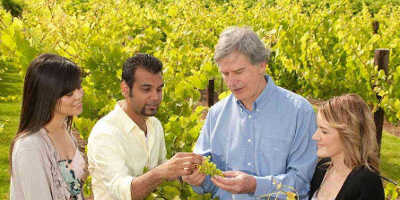How is wine made?
Written by: Cameron Ward
Published: 03/07/2019
Reading time: 3 mins
Wine has been around for thousands of years, produced by hundreds of different cultures and countries, each with their own style and taste.
Nowadays, the entire world has come together to share techniques and to discover others. Wine has never been as good as it is now! But what are the basics? What turns these seemingly ordinary grapes into bottles of sharp reds or crisp whites? With each type of brand producing different tastes us wine lovers to enjoy.
-
Pick the grapes
Although this may sound like the easiest chore when producing wine, it actually has a lot of thought process behind it. This is due to the taste a grape changing depending on when it is picked, with the acidity, sweetness, and flavour all being affected. Depending on the size of the vineyards, the grapes can be picked either by hand or by machine. As well, if picking falls during hotter days, night picking may be done instead, to increase the efficiency.
-
Crush the grapes
No matter what kind of wine or grape is involved, they will always be crushed. The destemmer machine is usually used for the majority of wines nowadays, essentially being a machine that removes the stems and bits you don’t want while crushing the grapes into liquid mush. For white wine, the skins and seeds are removed to get rid of any colour that will invade the liquid, whereas the skin is left on for red wines.
-
Fermentation
Fermentation is next on the agenda, with this being the step which will shape the taste. The sugar within the mixture converts into alcohol, with a range of techniques to accompany the different kinds of grapes. The most natural process is to simply add yeast, letting it ferment over time. For red wines, carbon dioxide is released, and usually fermented in warmer temperatures compared to whites. Red wine process usually continues until all the sugar is converted into alcohol, producing a dry wine. White wines can also be fermented until dry, but the sweet wine varieties stop before all the sugar is converted, making it a sweeter and less alcoholic drop. There is even the possibility that grapes will be pressed even after fermentation to strengthen rich smoothness.
-
Age the wine
Ageing can vary in time, place, and process. Wines can be aged for several months to several years, being placed in stainless steel or oak barrels, which can range in new oak, neutral, American, or French barrels. There are even various levels of being ‘toasted’ which is the barrel being charred by fire can make a difference. Overall a flavour of a wine can become more intense
-
Bottle the wine
Before bottling, the wine goes through a filtration process which removes the unwanted particulates still residing in the liquid. After this is the end, the wine is ready to be bottled! Which is usually done mechanically these days. After the wine bottle is slowly filled to the top, the winemakers will pop in a bit of nitrogen or carbon dioxide to displace any oxygen that might be lingering on top of the fill line. It’s corked and ready to be sold!




